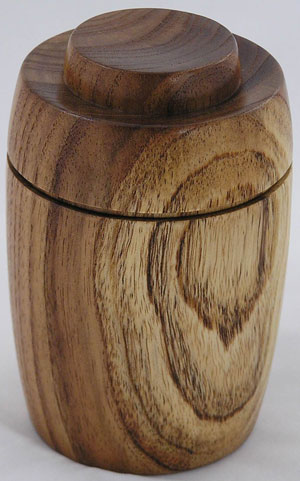
Our eZine staff fielded a question about mimosa wood in last issue’s Questions and Answers section – but it seems as though, while we can identify a mimosa during cocktail hour, we were barking up the wrong tree when we thought of the wood source. – Editor
“I read in the 6/29/10 ezine a question concerning mimosa trees. I think the question is referring to the Albizia julibrissin. It is a multi-stemmed tree that grows to be about 30′ tall. Each stem is up to 8″ in diameter, too small to make any practical lumber. I do believe that it is a hardwood.” – Howard Strause
“I think you’ve missed the boat on the question on mimosa wood. I’m quite sure the writer is referring to Albizia julibrissin, native to southern and eastern Asia. One of the common names is Persian silk tree. It is an invasive species that grows over most of the eastern U.S. and certainly like bad weeds in the southern U.S. It has quite pretty powderpuff flowers (thus is sometimes called the powderpuff tree), and the leaves close at night and during rainfall. Wikipedia lists its uses as follows: ‘The bark or cortex is used to cure bruises and as a vermicide. The seeds are used as a food for livestock and wildlife, and the sweetly-scented flowers are a good nectar source for honeybees.’ Because it grows so fast, I believe it is extremely weak and nearly useless as lumber and, I suppose, has low heating value for firewood, and is not-at-all rot-resistant as your expert suggests.” – William H. Snyder
“The mimosa wood in question is most likely from Albizia julibrissin, known as mimosa or silk tree. It is not native, but has been widely planted around the country. I’ve encountered it in southern Louisiana, where the sweet scent of the pink-and-white puff-ball blossoms totally perfumes the air on a summer evening.
“I’ve also seen some very large (for the species) trees in the Portland, Oregon and Vancouver, Washington, areas. The local library in Vancouver had an enormous mimosa tree near the front door. Unfortunately they are short-lived, rather weak-limbed trees and it had to be taken down. But a large mimosa in full bloom is absolutely gorgeous!
“The wood is light and somewhat coarse, but turns easily. It needs care in sanding to not get a washboard effect, and you can get a nice smooth finish. Turned green, it stays very pale with almost-yellow sapwood, but if allowed to season before working, it becomes a rich brown with darker lines, and cream sapwood. The color is enhanced with an oil finish.
“Since the trees are planted as ornamentals, they branch readily, and the wood grain is often pretty swirly. It makes pretty bowls and other ornamental items. Probably not a good cabinet wood, though, as it would be hard to get large boards!
“It is not a commercial species, so one would need to ask around to find the wood. Check especially after a severe storm, as the limbs break easily. It is VERY wet when green, but as I recall, if the ends are sealed quickly it dries well.

“I’ve attached a picture of a mimosa box I made recently, that shows the contrast between heartwood and sapwood. The tree grew in Portland, Oregon.” – Lea Montaire
No-Stink Poly
In response to another question, this one regarding getting the stink (from a polyurethane finish) out of a breadbox, a reader wrote in to share his experience with this type of finish. – Editor
“As the writer doesn’t mention what type of poly he used and the experts didn’t ask, I have found that any time I am finishing a project where I don’t want the smell of poly lingering, I use Minwax(R) water-based poly. Its low odor only seems to be noticeable while wet and is completely normally gone within an hour or so after completely dry.” – Ed Miller
Heavy Helpers at Hand
Instead of using the sand-filled windshield washer jugs shared in our previous issue’s Tricks of the Trade section, this reader had an alternative method of pressing flat the center area of a veneer being attached to a substrate. – Editor
“I’ve used the tip submitted by Serge Duclos, except I have a roll of butcher paper I got from a local restaurant supply house. It’s cheap, water-resistant, durable, and did I mention cheap?” – Doug Pocius
More Sayings Get Said
And, although too late for entry into the woodworking bromides contest, many, many eZine readers just couldn’t resist sharing more of their favorite woodworking-related sayings. – Editor
“Some more woodworking sayings:
“Sex is man’s way of sublimating the drive to browse through hardware stores.
“Definition of a professional woodworker: Someone who has almost enough clamps.
“Definition of heaven: The place where there are enough clamps.
“You need only two tools – WD-40 and duct tape. If it doesn’t move and it should, use WD-40. If it moves and shouldn’t, use the tape.
“Duct tape is like the Force. It has a light side and a dark side, and it holds the universe together.
“Klipstein’s Observation: Any product cut to length will be too short.
“Basic Law of Construction: Cut it large and kick it into place.
“Ehrlich’s Rule: The first rule of intelligent tinkering is to save all the parts.” – Dr. David L. Streiner
“My favorite is, ‘Zweimal abgeschnitten, und immer noch zu kurz! Since, if I remember correctly, you are from Minnesota and thus probably a Scandinuvian, I suppose I must translate that for you, which would be, ‘I’ve cut it off twice already, and it is still too short!'” – Dave Siegler





